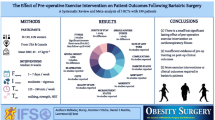Abstract
Background
Laparoscopic adjustable gastric banding (LAGB) is a common surgical treatment for obesity. Evidence for and against the association of aerobic exercise (AE) and weight loss after LAGB exists. We hypothesize that aerobic exercise is associated with improved weight loss and resolution of comorbidities after LAGB.
Methods
A review of a prospectively collected database identified patients who underwent LAGB over a 3-year period at a single institution. Body mass index (BMI), comorbidities, frequency, and duration of exercise were collected preoperatively and at 6, 12, 24, and 36 months postoperatively. Excess weight loss (EWL) was calculated. Groups were analyzed using Fisher’s exact test and ANOVA.
Results
Of the 145 LAGB patients, 120 had adequate data for analysis. AE had no association with weight loss at 6 months. At 12, 24, and 36 months following LAGB, patients who reported 150 min or more per week of exercise had an EWL of 35.5, 47.3, and 54.1 %, respectively, while those reporting 0–59 min per week of AE had an EWL of 25.3, 32.1, and 33.0 % (p = 0.03, 0.03, and 0.02, respectively). BMI and age was not statistically different among groups. Diabetes and obstructive sleep apnea were significantly improved in patients exercising at least 60 min per week as compared to those exercising 0–59 min.
Conclusions
AE is significantly associated with weight loss and comorbidity resolution after LAGB. We propose that patients who perform more AE will have higher levels of EWL.

Similar content being viewed by others
References
Flegal KM, Carroll MD, Kit BK, et al. Prevalence of obesity and trends in the distribution of body mass index among US adults, 1999–2010. JAMA. 2012;307:491–7.
Jakicic JM. The effect of physical activity on body weight. Obesity (Silver Spring). 2009;17 Suppl 3:S34–8.
Brolin RE. Bariatric surgery and long-term control of morbid obesity. JAMA. 2002;288:2793–6.
Cummings DE, Overduin J, Foster-Schubert KE. Gastric bypass for obesity: mechanisms of weight loss and diabetes resolution. J Clin Endocrinol Metab. 2004;89:2608–15.
Sjostrom L, Lindroos AK, Peltonen M, et al. Lifestyle, diabetes, and cardiovascular risk factors 10 years after bariatric surgery. N Engl J Med. 2004;351:2683–93.
Buchwald H, Avidor Y, Braunwald E, et al. Bariatric surgery: a systematic review and meta-analysis. JAMA. 2004;292:1724–37.
Bueter M, Thalheimer A, Lager C, et al. Who benefits from gastric banding? Obes Surg. 2007;17:1608–13.
Gouillat C, Denis A, Badol-Van Straaten P, et al. Prospective, multicenter, 3-year trial of laparoscopic adjustable gastric banding with the MIDBAND. Obes Surg. 2012;22:572–81.
Shaw K, Gennat H, O’Rourke P et al. Exercise for overweight or obesity. Cochrane Database Syst Rev 2006; CD003817
Cook CM, Schoeller DA. Physical activity and weight control: conflicting findings. Curr Opin Clin Nutr Metab Care. 2011;14:419–24.
Colles SL, Dixon JB, O’Brien PE. Hunger control and regular physical activity facilitate weight loss after laparoscopic adjustable gastric banding. Obes Surg. 2008;18:833–40.
Josbeno DA, Kalarchian M, Sparto PJ, et al. Physical activity and physical function in individuals post-bariatric surgery. Obes Surg. 2011;21:1243–9.
Das SK, Roberts SB, McCrory MA, et al. Long-term changes in energy expenditure and body composition after massive weight loss induced by gastric bypass surgery. Am J Clin Nutr. 2003;78:22–30.
Larsen JK, Geenen R, van Ramshorst B, et al. Binge eating and exercise behavior after surgery for severe obesity: a structural equation model. Int J Eat Disord. 2006;39:369–75.
Egberts K, Brown WA, Brennan L, et al. Does exercise improve weight loss after bariatric surgery? A systematic review. Obes Surg. 2012;22:335–41.
Chevallier JM, Paita M, Rodde-Dunet MH, et al. Predictive factors of outcome after gastric banding: a nationwide survey on the role of center activity and patients’ behavior. Ann Surg. 2007;246:1034–9.
Wing RR, Phelan S. Long-term weight loss maintenance. Am J Clin Nutr. 2005;82:222S–5S.
Thalheimer A, Bueter M, Wierlemann A, et al. Predictability of outcome in laparoscopic gastric banding. Obes Facts. 2009;2 Suppl 1:27–30.
Bond DS, Phelan S, Wolfe LG, et al. Becoming physically active after bariatric surgery is associated with improved weight loss and health-related quality of life. Obesity (Silver Spring). 2009;17:78–83.
Dixon JB, O’Brien PE, Playfair J, et al. Adjustable gastric banding and conventional therapy for type 2 diabetes: a randomized controlled trial. JAMA. 2008;299:316–23.
Acknowledgments
No funding source was used for this study. This manuscript has been read and approved by all authors. Amber Shada declares no conflicts of interest or financial disclosures. Peter Hallowell declares no conflicts of interest or financial disclosures. Bruce Schirmer declares no conflicts of interest or financial disclosures. Philip Smith declares no conflicts of interest or financial disclosures.
Funding
There is no outside source of funding for this study.
Conflicts of interest
The authors declare no conflicts of interest or financial disclosures.
This manuscript has been read and approved by all authors.
Author information
Authors and Affiliations
Corresponding author
Rights and permissions
About this article
Cite this article
Shada, A.L., Hallowell, P.T., Schirmer, B.D. et al. Aerobic Exercise is Associated with Improved Weight Loss after Laparoscopic Adjustable Gastric Banding. OBES SURG 23, 608–612 (2013). https://doi.org/10.1007/s11695-012-0826-6
Published:
Issue Date:
DOI: https://doi.org/10.1007/s11695-012-0826-6




